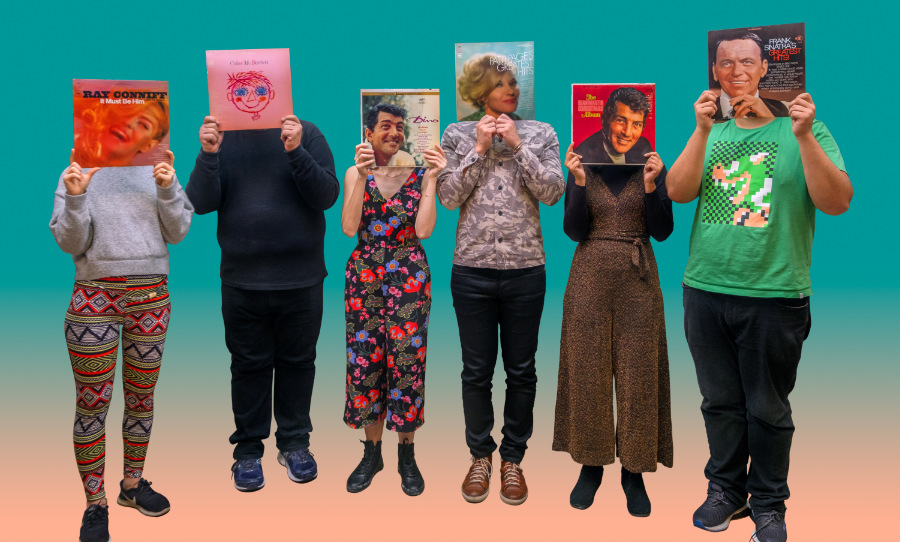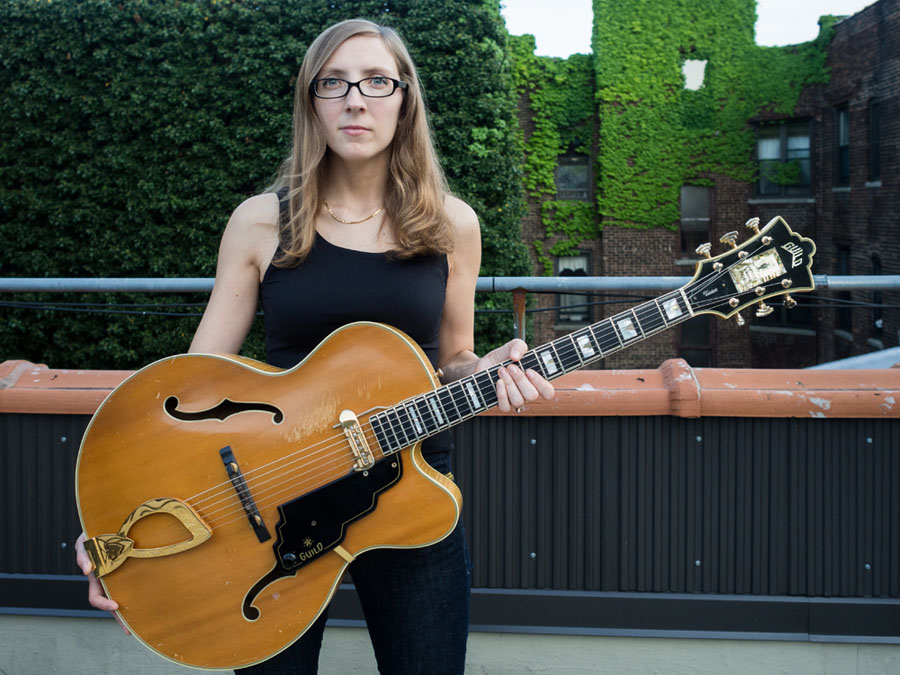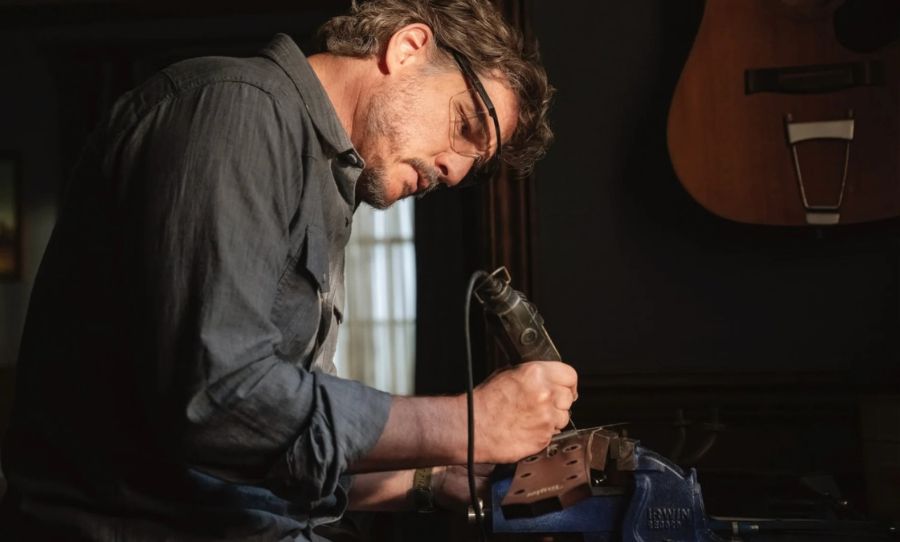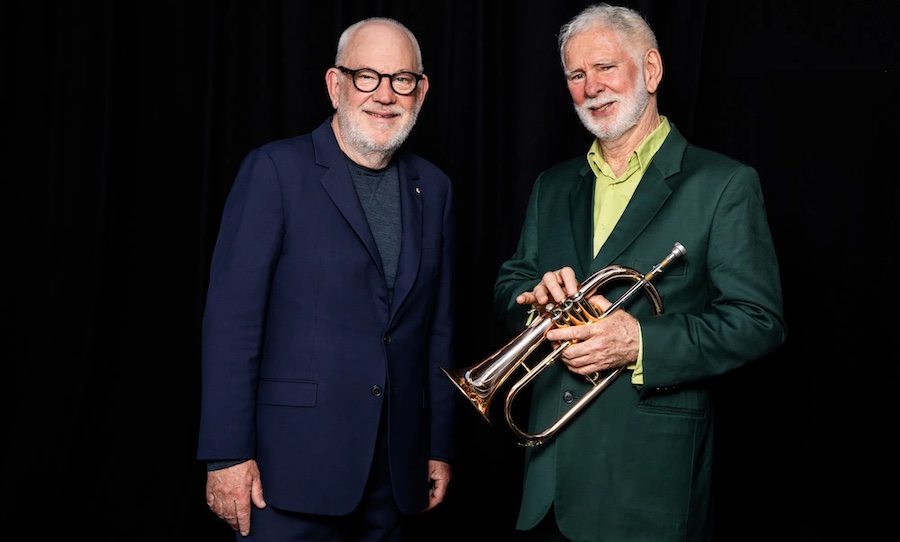Before the release of Artlessly Falling, Mary Halvorson talks about her compositional approach to guitar practise during lockdown.
From receiving the MacArthur Fellowship Award in 2019, to performing with people like Anthony Braxton, Bill Frisell, and John Zorn, Mary Halvorson has established herself as a leading composer, guitarist and bandleader in the avant-garde jazz scene. Her latest project Code Girl has been a personal exploration of all of these aspects.
Artlessly Falling is the follow up to the project’s debut, featuring an array of performers, including Robert Wyatt, and her long-standing trio of Michael Formanek and Tomas Fujiwara. The album revolves around structure — whether it’s being explored through distinct poetic forms, or blurred through improvisation.

ENMORE AUDIO: Congratulations on the album, It’s available to pre-order on Bandcamp now and releases on October 30. How has the lockdown changed the album release process for you?
MARY HALVORSON: You know, I was lucky in a sense because we had the album recorded before all this happened, we recorded it last December. So, it took us a little longer to get the mixing done (laughs), just because we had to do more stuff remotely than we usually would have. But actually, we stayed pretty on track. I think because we don’t have gigs it almost makes recordings all the more meaningful and important.
It was really nice for me to have this release to work on, to be able to do the mixing, and mastering, and artwork, and have something that I was looking forward to (laughs) during this period.
ENMORE AUDIO: For sure. So, was the mixing collaborative between the band?
MARY HALVORSON: No, I was working with the owner of the label, Nick Lloyd. He was also the engineer on the record. So, we had done a session in person, and then we were also at a certain point doing final tweaks remotely, you know sending stuff back and forth. So, I was working with him mostly.
ENMORE AUDIO: Yeah, I saw that Thumbscrew is playing at the Village Vanguard in a few weeks, right?
MARY HALVORSON: Yeah, we were (laughs). Unfortunately, we just found this out on Sunday, but I guess they’ve been having pretty extreme technical difficulties with their streams. It was freezing and crashing, the server was crashing or something, so they’ve had to take a few weeks off to figure it out. Unfortunately, that included our week, but the good news is that we were able to reschedule the concert. Do you know this venue Roulette, in Brooklyn?
ENMORE AUDIO: Yeah, I’ve heard of it.
MARY HALVORSON: So, they were really nice, and they had a free night on their calendar, so we were able to move the show to Roulette. So, we’re still doing it but it’s just one night now, on October 16 which is my 40th birthday, and we’re going to do the concert there. I’m really glad we were able to reschedule it, because like I said there’s so little happening this year, so when you have a concert it’s almost that much more meaningful. It gives you something to look forward to.
ENMORE AUDIO: Yeah definitely, even just playing with other people.
MARY HALVORSON: Yeah (laughs).
ENMORE AUDIO: Has it changed your daily practise, or relationship with the guitar, being at home more?
MARY HALVORSON: You know it has, and one of the positives for me during this period is that I’ve really had time to sit down and work on nuts and bolts, nerdy, tedious guitar stuff. Just trying to get better at the guitar. I think in the past, because I was travelling and playing in so many different bands, and I was trying to learn music for all these different projects, I didn’t have as much time to just focus on the guitar.
So, that’s been one thing that’s been positive, because I don’t have a lot of music to be learning for performances I’m able to really work on all kinds of stuff: chord voicings, technique stuff, ear training, just really sit with the guitar and try and improve. That’s something that I’ve wanted to do for a long time — to have a period where I can just work on the guitar. So, that’s been a large part of what I’ve been doing.
ENMORE AUDIO: Is that pretty set out? Whether it’s chord voicings, or ear training, or stuff like that. Do you have a regimented routine?
MARY HALVORSON: Yeah, I usually come up with these larger things that I want to work on and then I set a pretty strict routine, you know. So, going through chord voicings, and then going through different arpeggios, working on a lot of standard jazz repertoire, and then applying those things, playing a lot of tunes. I’ve been really into working on tunes. Not even necessarily with the goal of performing them, but just with the goal of using them as a tool to get better at the guitar.
ENMORE AUDIO: Does that seep into your composition too? I noticed in this album, there are a lot of arpeggio lines with the melody.
MARY HALVORSON: Not consciously, but I think whatever you’re working on, it’s going to seep in. And I have been working a lot on arpeggios, so then when I sit down to write, even if I’m not thinking about it like “I’m going to write something with an arpeggio” you know, it might just come out because that’s what I’ve been focusing on, a lot of harmonic based stuff. Yeah, so you could be on to something (laughs).
ENMORE AUDIO: Cool (laughs)! So you were mentioning doing mixing online, but for the recording of the album how did the pre-production stuff work? With rehearsals, and leading a band through composition and improvisation.
MARY HALVORSON: Well, I guess the big difference between this record and the previous Code Girl record is that the previous Code Girl record we kind of, got together, practised, played maybe two gigs, and then we went right into the studio. And everything was really new, it was a new band. This time it wasn’t a new band, so we had already established something of a sound and a rapport, but also we did an entire tour, like a two-week tour, and then another couple of performances before recording.
So by the time we recorded, we really knew the music well because we’d been playing it every night on the road. For me that’s always ideal, to get to the point with a band where you’re really comfortable, and then make the recording. So a lot of it for me is just working it out on the road. We didn’t have a lot of rehearsals. Everybody learned the tunes on the road, and then we started playing it on the road, and as we did, it kind of developed it and found logical tweaks and directions.
ENMORE AUDIO: And so, is the music written for these particular people you’re playing with?
MARY HALVORSON: Yeah, one hundred percent. When I sat down to write it, I was thinking specifically about those musicians, and what they sound like, and tried to write parts for them. So that was important to me, to think about exactly who was in the band and what their strengths are, and how I might imagine them sounding in a particular song.
ENMORE AUDIO: Yeah, and you play with some of these people a lot. Is there a lot of free improvising on the album? Because to me it’s quite hard to tell what’s written or free, it feels like there are written parts and then it’ll go off and then come back at some point.
MARY HALVORSON: Yeah, it’s good that it’s hard to tell. I think that’s part of my goal, that it shouldn’t feel like “now it’s the composed part, and now they’re improvising”. I think it’s nice when there’s a little bit of blurring between those things, but that being said I do think of this largely as a song project.
It’s pretty heavily composed, but there’s a lot of improvisation in it, and I tried to use improvisation in different ways so it’s not always the same type of improvisation. For example, there are moments where maybe a musician is playing over a set form, there might be moments where something is totally free, and then we somehow get back to the next section of the song.
But I think probably in terms of my projects, this is one of the more structured, more highly composed projects. But I still like to leave room for things to happen, you know like when we play the songs live, they tend to be much longer, and there’s a lot more improvisation. On the record, I wanted to have versions that were a little more compact.
ENMORE AUDIO: So, on something like the track Artlessly Falling you start with this really ‘effected’ guitar paired with intimate vocals. Is that something that was written, or did you try out a few different approaches while on the road?
MARY HALVORSON: You know, there are six verses right, and I wanted to have a build, and then there’s what’s called an envoi. The last section of the poem, which is sort of a different section at the end. But there are six verses leading up to that, and so when I was composing it I wanted it to have a steady build throughout.
So, I thought starting with just guitar and voice, then adding bass, then drums, then the horns start to sneak in, so by the time you get to the sixth stanza it’s pretty full-on. So that was the goal in the composition — to build that arc, and I really like the intimacy of starting with just voice and guitar. But the only thing that really was ‘written’ for me is the chord voicings, and it’s rubato so I was able to play around with them and add effects, like you said.
The melody was also composed but Amirtha plays around with it quite a bit. So the hardest thing with that one, that we worked out a lot on the road, was the pacing. Because I wanted it to move along pretty quickly, it’s a lot of words, so you know, I was saying it should feel like a mouthful. These words keep coming and it keeps building and building in energy. So that’s one of the more concept-based, and less composed pieces I think. Just because, like I said there’s minimal information, just chord voices and melody, and most of it is rubato.
ENMORE AUDIO: So, you’re just trusting the band to take the information and interpret it?
MARY HALVORSON: Exactly, and the horn parts are-up until the very end, the horn parts are completely improvised.
ENMORE AUDIO: Yeah, right.
MARY HALVORSON: So, they’re seeing voicings, and the melody, and the words, and they’re just playing along. Same thing with bass and drums, so it’s really just a guitar part and melody up until the ending section.
ENMORE AUDIO: So, were the lyrics written before the music?
MARY HALVORSON: Always. For me, that sort of makes-I know a lot of people do it the other way around, but for me, it’s the more logical way to do it. Because I wrote these in all different poetic forms, so all of the songs have a very set structure. Sometimes they even have a rhyme scheme, you know depending on what the form was.
So for me, if I have the poem first it’s so much easier to write the song second because then I know what the song’s about, I know what the meter is. If there’s an irregular meter in the poem I might write the song in an irregular fashion to fit. So, I really try to fit the songs around the words, and that’s really enjoyable to me. I’ve always done it that way, I’ve never tried to write the music and fit the words somehow after, it just doesn’t work for me.
ENMORE AUDIO: You were mentioning just having chord voicings, is that something you sit at home and practise, different ways of getting through it or improvising through it? Or is the technical practise more of a way to prepare you for improvising in performance?
MARY HALVORSON: I think the composing part of it is pretty improvisational, so usually what I’ll do is just sit down and start playing guitar. And I might have the lyrics printed out, I’m looking at the lyrics, and then I just start playing guitar and I sing also while I’m playing. Then I keep messing around until I get something that I like, then I’ll just write it down or record it and keep adding to it.
I’m never thinking about theory, I don’t think like “oh that was an A minor and now I’m going to a C”, I don’t really think like that. In fact, I try not to think about that stuff, and just purely do it by ear, and try to do it pretty quickly. So almost the first thing that comes to your mind I think is often the best idea. Not always (laughs), sometimes you have to take some time with it. But yeah kind of an improvisational approach to writing a set of chords, that’s kind of how that song went.

ENMORE AUDIO: Yeah cool, and is that a kind of approach you take when you’re in free improvising situations, like trying not to think verbally, or something like that?
MARY HALVORSON: Yeah, I tend to enjoy that. I mean when I’m practising, I’m thinking pretty logically about what I’m playing, but it’s nice to not have that stuff in your head when you’re actually playing, especially in a free context. Because sometimes you know, if you’re playing something and you’re just thinking “ok I’m in E minor”, sometimes it can be confining.
But if you’re purely doing it by ear, even if you know you’re in E minor, it’s usually not that hard to figure that out (laughs) when you’re playing something. But if you’re not thinking about it in that way, you feel like you can play stuff that might fit within that chord, you can play stuff that rubs against it, you could move to something else.
So I think doing things by ear, to me, that’s the ultimate goal. And I’m not there yet, but to have such a good ear that you don’t have to think about any of the theory, you’re just hearing stuff and then being able to play exactly what you hear. So, I think it’s that kind of ear training and facility on your instrument, that ideally, you’re not kind of beholden to patterns and your brain isn’t getting in the way of whatever you’re trying out get out.
ENMORE AUDIO: What does your ear training practise look like?
MARY HALVORSON: Right now? Oh, it depends. I’ve done before these kind ‘ear training programs’, where you have to identify a chord progression or something and write it down. But as far as the guitar, I mean there’s a bunch of things I do.
One is that, let’s say you have a melody to a standard, or any melody, just a song you know. To play it and then on guitar to play it in all twelve keys, go around the cycle of fourths or something, play it in all twelve keys but in the same position on guitar. So you have to purely go by ear, you can’t go by any kind of pattern you might have figured out, because guitar is a very pattern-oriented instrument.
And I think also for me just working on playing standards, playing over changes and being able to head and identify those changes. That’s been really helpful for me as far as ear training.
ENMORE AUDIO: So, kind of getting out of the pattern-based guitar playing, where you might see a C chord and play a shape or something.
MARY HALVORSON: Yeah don’t get me wrong, patterns can be great. One of the essential things about the guitar is the patterns but you can’t get stuck in the patterns either. You’re a guitar player, right?
ENMORE AUDIO: Yeah.
MARY HALVORSON: Let me just show you this really quick, you’re not going to be able to use this in your interview I guess (laughs). But this is an example of when patterns can be really cool. It’s this little book somebody gave to me, it was a guitar player. So, what he did was, he made all these little fretboard patterns and then he analysed what they are, which is hilarious, they’re all super complicated.
[Holds up Nonmusical Patterns and their Musical Uses (For Guitar in Standard Tuning) by Chris Weisman]
But there are just these beautiful shapes and you can play them, you don’t even need to know how to read music. It’s just this visual pattern-based thing and they sound amazing. So, I also like patterns where you’re not even thinking. It’s just a pattern, but sometimes the patterns can be really beautiful and create something really cool.
ENMORE AUDIO: I don’t know if you’ve seen this, but it reminds me of what Miles Okazaki has been doing with his daily pattern-practise posts on Instagram.
MARY HALVORSON: Yeah! Do you have his book?
ENMORE AUDIO: Yeah, I do!
MARY HALVORSON: It’s so cool! It’s almost overwhelming, it’s like any page you open up there’s an infinite amount of possibilities of things you could explore with one simple concept or one pattern. I think that book is a great example of just how much there is out there, you know there’s just so much you could choose to explore it’s almost overwhelming (laughs).
ENMORE AUDIO: Yeah, totally.
MARY HALVORSON: But I love Miles, he’s an amazing guitar player, and his focus is really cool.
ENMORE AUDIO: I think of your playing as having a really hard attack and a really kind of defined aesthetic. Is that something that just came out of playing guitar, that kind of approach?
MARY HALVORSON: You know it’s funny, I feel like for whatever reason that I don’t know why, from the second I picked up guitar I wanted to hit it hard (laughs). Even when I was a kid I did that. But I think later as ai kind of developed my playing, a big part of that for me comes from the influence of upright bass. Because I love the sound of just how strong bass players will attack, and you can really hear the wood and the instrument, and when they hit an open string it resonates so much.
I think this is partly why I was drawn to such a large hollow body guitar — you can actually hear the physicality of the instrument and hear the wood. You know, in addition to having an amplified sound. But I like having both of those elements present, and you can hear the sound of the amp, and effects if there are any. But then you can also hear the natural sound just coming from the wood.
ENMORE AUDIO: Yeah definitely and playing without reverb especially you can hear every detail.
MARY HALVORSON: Yeah, I’ve never been a big fan. I mean I don’t mind it for other people’s sounds, they’re totally different, and I really enjoy sounds that are totally different from mine. But for my own sound? No reverb on the amp when I play.
ENMORE AUDIO: Indeed. Thanks so much for your insights today.
MARY HALVORSON: Yeah totally!
Mary Halvorson’s Code Girl Artlessly Falling is out on October 30 via Firehouse 12 Records. Visit her website for all the details.



